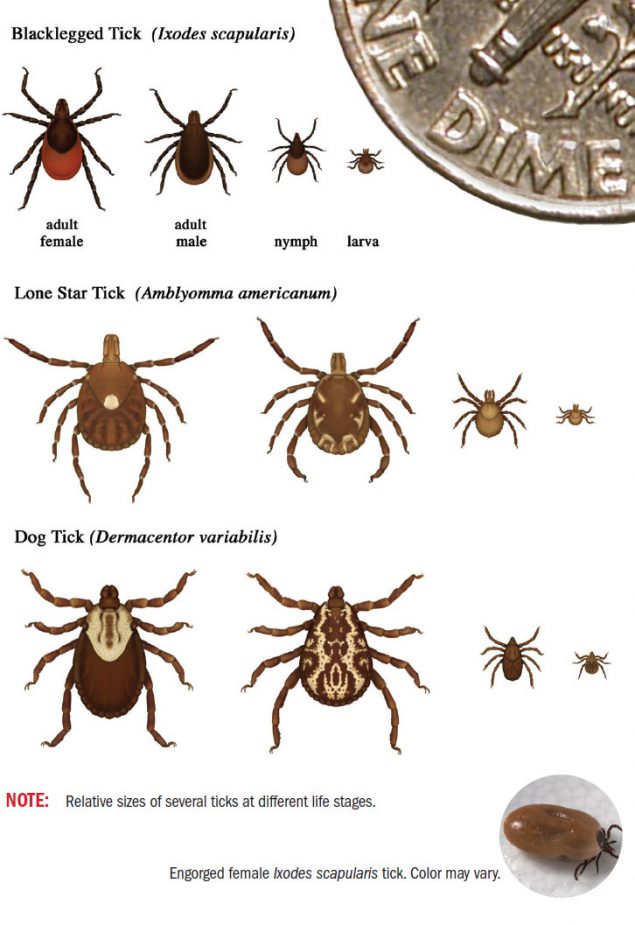by KATE EVANS
Ticks are already prevalent this spring and area physicians are treating people for tick bites and Lyme disease.
Health officials urge everyone to keep checking for ticks on themselves, their children and pets and watching for signs of tick bites, Lyme disease and other tick-borne illness.
Lyme disease
Lyme disease is a bacterial infection caused by a bite from the deer tick or black-legged tick. Lyme disease symptoms can include fever, headache, flu-like symptoms, swollen lymph nodes and muscle and joint pains for up to a week with no obvious cause.
Symptoms can begin three to 30 days after a tick bite. Some patients get a very red round or oval rash that’s at least 4-6 inches in size.
Sometimes that rash will have an outer ring with a clearing inside and a red center, creating a bull’s eye appearance. The rash can get very large. Around 10% to 20% of patients have no rash.
If untreated, Lyme disease can spread to the joints, heart and nervous system and in rare cases, it can be fatal. If you think you’ve been exposed to Lyme disease and have symptoms, especially a rash or a rash with a bull’s eye, see your physician as soon as possible. The sooner Lyme disease is treated with antibiotics, the better.
Most cases of Lyme disease occur in the late spring through early fall, but can happen year-round as ticks can remain active during mild winters. The deer ticks that carry Lyme disease are very small.
According to the Maryland Division of Natural Resources website, most human cases of Lyme disease are caused by immature ticks, which are called nymphs — those less than two millimeters (.08 inches) in size.
Adult deer ticks can also transmit Lyme disease but are usually discovered on the body before they’ve had a chance to spread the disease since they’re larger.
Berkeley Springs physician Dr. Amanda Michael sees patients year-round with ticks and tick bites.
Michael said previously that a tick has to be attached for 36 hours to transmit the bacterium that causes Lyme disease. Shower and check yourself as soon as you come in from the yard and use DEET or OFF for tick prevention.
With Lyme disease, usually 95% to 97% of patients respond to a full 21 to 28 day course of doxycycline, Michael said. Those that don’t respond to doxycycline are administered intravenous antibiotics.
River Bend Family Medicine nurse Lindy Morris said it’s just the start of tick season, but their Hancock practice has seen some patients with ticks and tick bites. They’ve seen mostly deer ticks at their medical practice this year.
What sometimes patients think are deer ticks – because they’re so small — are actually dog ticks, she noted. The American dog tick can carry Rocky Mountain spotted fever.
Morris said that they’ve seen some patients with tick bites that they’ve treated with a single prophylactic dose of antibiotics as a preventative against Lyme disease with patients reporting the size of the tick that was attached. They’re given a full course of antibiotics treatment if a patient has the bull’s-eye rash.
The Eastern Panhandle is the hub for Lyme disease in West Virginia and the disease is very prevalent in Pennsylvania and Maryland.
Centers for Disease Control and Prevention (CDC) data shows that Pennsylvania has led the nation in reported confirmed and probable Lyme disease cases from 2006-2018, with 10,208 cases in 2018. Maryland had 1,382 total confirmed and probable Lyme disease cases in 2018, Virginia 1,139 cases and West Virginia 671 cases.
Other tick-borne illnesses
While the majority of area tick-borne illnesses are Lyme disease cases, sporadic cases of rare tick-borne diseases such Rocky Mountain spotted fever, tularemia, ehrlichiosis, and anaplasmosis occur regionally. Symptoms of most other tick-borne diseases are similar to Lyme disease with fever, headache, muscle aches, joint pain and fatigue.
Some 133 cases of Powassan virus, an extremely rare and serious neuroinvasive disease spread by infected ticks, have been reported in the northeastern United States and the Great Lakes area from 2009 to 2018, according to the Centers for Disease Control and Prevention. Pennsylvania has had six cases and Virginia one case. The virus can cause encephalitis.
Lone star tick
Lone Star ticks are becoming more prevalent in the area. An adult female Lone Star tick has an identifying white spot on its back The tick can be found from central Texas and Oklahoma eastward across the southern states and along the Atlantic coast.
The lone star tick can cause people to develop an allergic reaction to red meat. Many don’t realize it until they start getting hives, Dr. Michael said. Other red meat allergy symptoms can include rash, difficulty breathing, dizziness, nausea, severe stomach pain and throat swelling.
The Lone Star tick can also cause STARI (Southern Tick-Associated Rash Illness), which causes a rash very similar to the Lyme disease rash. Patients may also experience fatigue, headache, fever, and muscle pains.
Removing ticks
Remove ticks carefully as soon as they are found. The CDC advises using a fine-tipped pair of tweezers and pulling upward with steady, even pressure. Clean the tick bite site and wash your hands. Don’t crush a tick with your fingers.
Check for ticks daily on yourself, kids and pets. Be sure to check unusual places on the body such as between the toes, inside the bellybutton and behind the ears. Use tick control products on pets.









